 |
| For Your Information |
| If there is something that may be of interest to you, we will try to make that information available. |
|
|
 |
Fall Severe Weather Awareness |
 |
| |
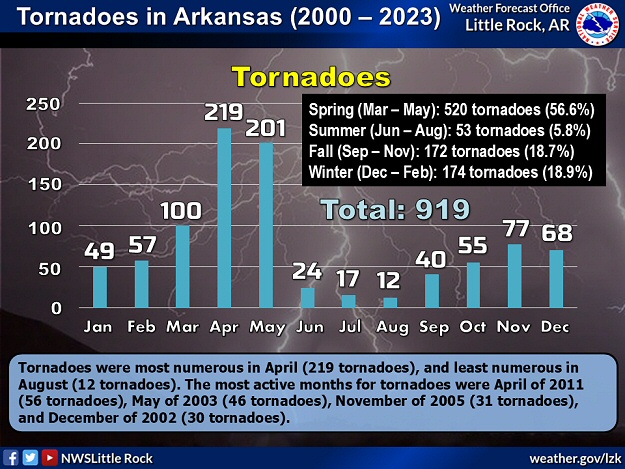 |
| In the picture: Tornadoes in Arkansas (2000 to 2022). Of the 891 tornadoes spawned in this twenty three year period, 339 tornadoes (38%) occurred in the fall/winter (September through February). |
|
| |
|
Although most people associate the spring months with severe storms, Arkansas typically experiences a secondary severe weather season in the fall or early winter about two years out of every three. Almost four of ten tornadoes from 2000 to 2022 occurred between September and February.
|
| Beware El Niño |
|
It appears we may experience a rare super El Niño (when water temperatures are at least 2.0°C above average along the equator in the Pacific Ocean) in late 2023/early 2024. When moderate to strong El Niños have been in place previously, there were several instances of tornado outbreaks and/or heavy to excessive rain across Arkansas from October through December (in 1982, 1987, 1991, 2002, 2009, and 2015).
|
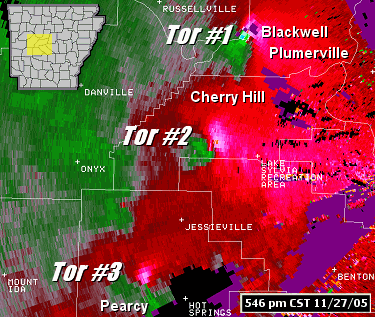 |
In the years 2001, 2002, 2004, 2005, and 2014, tornadoes were most prevalent across the state in the fall. In 2009 and 2015, there were about the same number of tornadoes in the fall as in the spring. There were as many tornadoes (5 of them) in October of 2019 as March/April, and the strongest tornado (rated EF2) of the year traveled 31 miles through Benton County on the 21st. The busiest month for tornadoes (16 of them) in 2022 was November. |
| In the picture: The WSR-88D (Doppler Weather Radar) showed areas of strong rotation with tornadoes produced on 11/27/2005. Tor #1 tracked through Blackwell (Conway County), Tor #2 hit Cherry Hill (Perry County) and Plumerville (Conway County) and Tor #3 affected areas near Pearcy (Garland County). By the time the event was over, two dozen tornadoes were counted. |
|
|
| In the video: A tornado ripped through Leachville (Mississippi County) in northeast Arkansas on 12/10/2021. A fatality occurred at a discount store that was flattened. The video is courtesy of Brian Emfinger via Twitter. |
|
| |
|
The strongest and deadliest tornado (rated EF4) of 2021 affected Craighead and Mississippi Counties and killed two people on December 10th. This was part of a huge severe weather episode, with a dozen tornadoes tallied in the northeast. The deadliest tornado of 2010 was spawned on December 31st in Washington County. Four fatalities resulted.
|
| One for the Record Books |
|
This event on December 10-11, 2021 was the most impactful from northeast Arkansas into portions of Missouri, Illinois, Kentucky, and Tennessee. An incredible five dozen tornadoes were counted, and eight of these were rated EF3 or higher. Across the country, this was the deadliest tornado episode on record: (1) in December (90+ fatalities), and (2) since April/May, 2011.
|
|
People who have lived in Arkansas awhile likely remember December of 1982, when multiple tornadoes hit on December 2nd and again on Christmas Eve.
|
| In 2008, the Super Tuesday Tornado Outbreak unfolded on February 5th. One long track tornado claimed thirteen lives. |
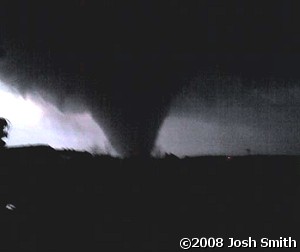 |
| In the picture: A tornado approached Clinton (Van Buren County) from the southwest toward sunset on 02/05/2008. The tornado tracked a state record 122 miles through seven counties, and was responsible for thirteen fatalities. The photo is courtesy of Josh Smith. |
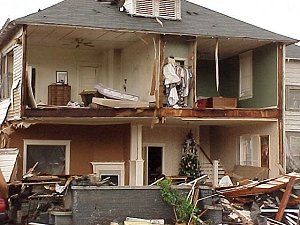 |
In 1999, there were a lot of tornadoes (56 of them) on January 21st. In 2012, tornadoes were most numerous on January 22nd. A year later, five tornadoes materialized on January 29th. |
| In the picture: This home on Main Street in Beebe (White County) resembled a doll house (rooms visible from the outside) after it was hit by a tornado on 01/21/1999. This was one of fifty six tornadoes spawned during this outbreak, mainly along the Interstate 30 and U.S. Highway 67/167 corridors. It remains the largest outbreak in state history. |
| In 2009, fifteen tornadoes were counted in mainly southern Arkansas on October 29th. This event featured widespread serious flooding. |
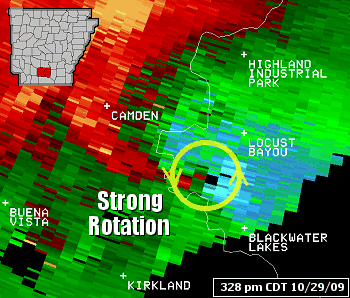 |
| In the picture: The WSR-88D (Doppler Weather Radar) showed strong rotation and a possible tornado approaching areas between Camden (Ouachita County) and Locust Bayou (Calhoun County) at 328 pm CDT on 10/29/2009. |
| In the fall and winter, severe weather usually takes place when a strong cold front or storm system aloft collides with unusually warm and humid air. It is very important to keep up with the weather if well above normal temperatures are observed when it should be cold. Find out if severe weather watches and warnings are in effect. Typically, many people are caught by surprise when severe storms pop up during the cooler months. That is because these storms are supposed to happen in the spring. |
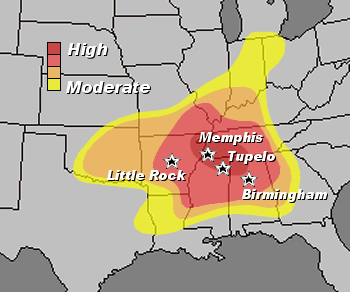 |
The surprise factor of cold season severe storms was mentioned in a 2007 study conducted by Dr. Walker Ashley at Northern Illinois University. According to Dr. Ashley, not being prepared is one reason people are vulnerable to killer tornadoes in this part of the country. Other factors include a high percentage of manufactured homes, heavily forested terrain to block the view of tornadoes, and the close proximity of the Gulf of America to sustain storms well after sunset (while people are asleep). |
| In the picture: Relative frequency of killer tornado events from 1950 to 2004 (adapted from a graphic in a study by Dr. Walker Ashley). |
|
So far in 2023, 30 tornadoes were confirmed in Arkansas through early November (less than the annual average of 37 tornadoes). There may be more severe weather in our future as El Niño strengthens (or as water near the equator in the Pacific Ocean warms up). As this happens, precipitation is expected to ramp across the southern United States in November/December. This could include one or more rounds of severe storms.
|
| Safety Rules/Other Points |
| 1. |
Be sure you know the difference between a watch and a warning. The National Weather Service issues a Tornado Watch when tornadoes are possible. A Tornado Warning is issued when a tornado has been indicated on the WSR-88D (Doppler Weather Radar) or has been sighted. |
| 2. |
Counties and cities are mentioned in Tornado Warnings, so it is a good idea to be familiar with locations near you. If you are new to the area, keep a map handy for reference. |
| 3. |
Make sure that you have a reliable way to receive weather information. Battery-powered NOAA Weather Radios are an excellent way to keep up with the weather, even if your power has gone out. A battery-powered radio is also a necessity if you are planning to be outdoors. |
| 4. |
If you are involved in an activity, and your focus is not on the sky (such as at a school, stadium or place of worship), make sure that someone has been designated to keep an eye on the weather and to listen for the latest watches and warnings. |
| 5. |
A tornado shelter, tornado cellar, or a safe room is the safest place to be, but most homes do not have these. The next safest place is usually a basement, but these are not common in Arkansas. If you do not have any of these, go to an interior room or hallway on the lowest floor of a house or building. You want to put as many walls as possible between you and the outside. You can protect yourself further by getting under a mattress or a heavy piece of furniture. |
| 6. |
Many businesses, such as large stores, shopping malls, hospitals, nursing homes, and schools have pre-arranged safety plans and designated safe areas. If you are in one of these places, follow the instructions given inside these buildings. |
| 7. |
Stay away from windows. |
| 8. |
If you are in a vehicle, your best option is to move to a sturdy building. |
| 9. |
Mobile homes, even if tied down, offer little protection during a tornado, and should be abandoned. |
| |
|
Remember that flying debris causes the most casualties in a tornado. Hiding under a bridge is not a good idea because you are exposed to flying debris.
Keep in mind that the elderly, the very young, and people with physical or mental challenges will often need more time to get to safety. Make special provisions if you are a care-giver for these people.
|
|
|
|